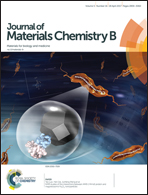Redox/pH dual-sensitive hybrid micelles for targeting delivery and overcoming multidrug resistance of cancer†
Abstract
A redox/pH dual-sensitive graft copolymer, poly(β-amino ester)-g-D-α-tocopherol polyethylene glycol succinate (PBAE-g-TPGS), was synthesized through a Michael-type step polymerization using disulfide linkage-containing TPGS macromonomers. Pluronic F127 (F127) and folate-F127 conjugation were introduced to prepare paclitaxel (PTX)-loaded hybrid micelles to improve their biocompatibility and serum stability and also to achieve targeted delivery. The hybrid micelles exhibited in vitro redox/pH-sensitive PTX release, enhanced cellular uptake through receptor-mediated endocytosis, and strengthened anticancer activities in both the drug-sensitive human breast cancer MCF-7 and drug-resistant MCF-7/ADR cells. P-Glycoprotein inhibition by TPGS and folate-mediated targeted delivery helped overcome multidrug resistance (MDR) and increase the therapeutic efficiency of the drug, leading to good anticancer effects in the MCF-7/ADR xenograft model. Overall, the folate-modified redox/pH-sensitive hybrid micelles provided a three-step approach to enhance anticancer activities via targeted delivery, controlled release, and depressed drug efflux; thus, these micelles may be a powerful weapon against MDR cancers in the future.



 Please wait while we load your content...
Please wait while we load your content...